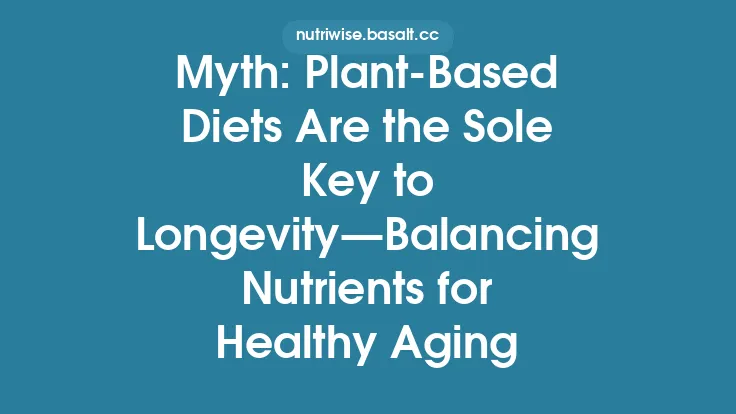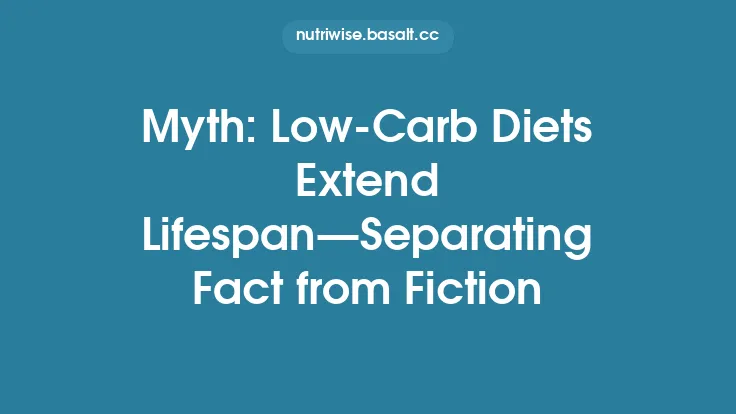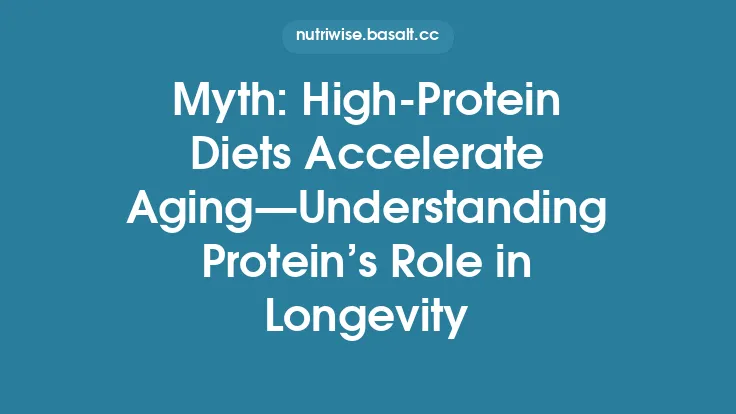The promise of a single “longevity diet” that will automatically add years to anyone’s life is a seductive narrative that appears in countless articles, social‑media posts, and even some commercial diet programs. It taps into a deep human desire for a simple, universal solution to a complex problem: how to age well. Yet the scientific evidence that has accumulated over the past two decades tells a very different story. While certain dietary patterns are associated with healthier aging at the population level, the magnitude of their benefit—and even the direction of the effect—can vary dramatically from person to person. The emerging consensus among nutrition scientists, gerontologists, and clinicians is that longevity is best supported by personalized nutrition, a strategy that tailors dietary recommendations to an individual’s unique genetic makeup, gut microbiome, metabolic profile, life stage, and health status.
Below, we unpack why the “one diet fits all” myth persists, explore the biological factors that drive individual responses to food, and outline practical, evidence‑based steps you can take to craft a nutrition plan that aligns with your own longevity goals.
Understanding the Appeal of One‑Size‑Fits‑All Longevity Diets
- Simplicity and Marketability – A single, easy‑to‑remember set of rules (e.g., “eat more greens, cut carbs, and avoid processed foods”) is far more marketable than a nuanced, individualized approach. It reduces decision fatigue and creates a clear, actionable message for consumers.
- Observational Success Stories – Population studies that link certain dietary patterns—such as the Mediterranean or traditional Okinawan diets—to lower rates of chronic disease and longer average lifespans are compelling. However, these studies capture average effects across diverse groups, not guarantees for any given individual.
- Cultural Narratives – Many cultures have long‑standing food traditions that are celebrated for promoting health and longevity. While these traditions often contain valuable wisdom, they were developed in specific environmental and genetic contexts that may not translate directly to modern, globally mobile populations.
- Confirmation Bias – When a person adopts a popular longevity diet and experiences improved well‑being, they may attribute the change solely to the diet, overlooking other concurrent lifestyle modifications (e.g., increased physical activity, better sleep, reduced stress).
These factors combine to create a powerful myth: that a single dietary blueprint can universally extend lifespan. The reality, as we’ll see, is far more intricate.
Why Individual Biology Matters
Human beings are not a monolithic species; we are a mosaic of genetic variations, metabolic capacities, and environmental exposures. Two people eating the exact same meals can experience dramatically different outcomes in terms of blood glucose regulation, lipid profiles, inflammation, and even cellular aging markers. The key drivers of this variability include:
- Genetic polymorphisms that affect nutrient absorption, metabolism, and signaling pathways.
- Gut microbiome composition, which determines how dietary components are transformed into bioactive metabolites.
- Epigenetic modifications that influence gene expression in response to diet and lifestyle.
- Age, sex, and hormonal status, which shape nutrient requirements and metabolic efficiency.
- Health conditions and medication regimens, which can alter nutrient needs and interactions.
Because these factors differ from person to person, a diet that optimally supports longevity for one individual may be suboptimal—or even detrimental—for another.
Genetic Variability and Nutrient Metabolism
1. Nutrient‑Processing Enzymes
Genes encode enzymes that catalyze the breakdown, transport, and utilization of macronutrients and micronutrients. Common polymorphisms include:
| Gene | Function | Example Variant | Potential Impact on Longevity Nutrition |
|---|---|---|---|
| MTHFR | Folate metabolism | C677T | Reduced conversion of folate to its active form, increasing homocysteine levels; may benefit from higher dietary folate or methylated supplements. |
| APOE | Lipid transport | ε2, ε3, ε4 | ε4 carriers have higher LDL cholesterol response to saturated fat; may need stricter control of dietary cholesterol and saturated fat. |
| FADS1/FADS2 | Polyunsaturated fatty acid (PUFA) desaturation | Various SNPs | Altered conversion of plant‑based omega‑3 (ALA) to EPA/DHA; some individuals may require direct EPA/DHA sources (e.g., fatty fish or algae oil). |
| LCT | Lactase persistence | -13910 C/T | Determines ability to digest lactose; lactose intolerance can affect calcium intake strategies. |
Understanding an individual’s genotype can guide adjustments such as increasing specific micronutrients, selecting alternative protein sources, or modifying fat quality.
2. Pharmacogenomics and Diet Interactions
Certain medications (e.g., statins, antihypertensives) interact with dietary components. For instance, individuals on warfarin must monitor vitamin K intake, while those on certain antihyperglycemics may need to balance carbohydrate timing. Genetic variations in drug‑metabolizing enzymes (e.g., CYP450 family) further modulate these interactions, underscoring the need for coordinated medical‑nutritional planning.
The Role of the Gut Microbiome in Aging
The trillions of microbes residing in the gastrointestinal tract are now recognized as a “second genome” that profoundly influences healthspan. Their relevance to longevity nutrition lies in three core mechanisms:
- Metabolite Production
- Short‑Chain Fatty Acids (SCFAs) such as acetate, propionate, and butyrate are generated from fermentable fibers. SCFAs support intestinal barrier integrity, modulate immune function, and have been linked to reduced systemic inflammation—a key driver of age‑related disease.
- Trimethylamine N‑oxide (TMAO), derived from dietary choline and carnitine, is associated with cardiovascular risk. Individuals with a microbiome predisposed to high TMAO production may benefit from moderating animal‑derived choline sources.
- Bile Acid Transformation
Gut bacteria convert primary bile acids into secondary forms that act as signaling molecules influencing lipid metabolism, glucose homeostasis, and even cellular senescence pathways.
- Immune System Education
Early‑life microbial exposures shape immune tolerance. In older adults, dysbiosis (imbalanced microbiota) can exacerbate “inflammaging,” the chronic low‑grade inflammation that accelerates tissue decline.
Personalization Implications
- Fiber Type Matters: Not all fibers are equal. Soluble fibers (e.g., in oats, legumes, psyllium) are more readily fermented into SCFAs, while insoluble fibers (e.g., wheat bran) primarily add bulk. Tailoring fiber sources to an individual’s microbial capacity can maximize SCFA production.
- Probiotic and Prebiotic Selection: Strain‑specific probiotics (e.g., *Bifidobacterium longum subsp. infantis for infants, Akkermansia muciniphila* for metabolic health) may be beneficial, but efficacy depends on baseline microbiome composition. Prebiotic compounds such as inulin, arabinoxylan, or resistant starch can selectively nourish beneficial taxa.
Microbiome profiling—via stool metagenomic sequencing—offers a practical route to identify these personalized opportunities, though cost and accessibility remain limiting factors for widespread use.
Epigenetic Influences and Dietary Interactions
Epigenetics refers to reversible modifications to DNA and histone proteins that regulate gene expression without altering the underlying genetic code. Diet can both write and erase epigenetic marks, thereby influencing aging trajectories.
- DNA Methylation Clocks: Algorithms that estimate biological age based on methylation patterns (e.g., Horvath’s clock) have shown that certain dietary patterns—particularly those rich in polyphenols, omega‑3 fatty acids, and low in processed sugars—correlate with slower epigenetic aging.
- Histone Acetylation: Short‑chain fatty acids like butyrate act as histone deacetylase inhibitors, promoting a chromatin state associated with anti‑inflammatory gene expression.
- MicroRNA Modulation: Nutrients such as curcumin, resveratrol, and sulforaphane can alter microRNA profiles that regulate pathways involved in cellular senescence and autophagy.
Because epigenetic responses are highly context‑dependent, the same food can have divergent effects depending on an individual’s existing epigenome, lifestyle stressors, and exposure history. Personalized epigenetic assessments are still largely research tools, but they illustrate why a static “longevity diet” cannot account for dynamic molecular landscapes.
Life‑Stage and Sex Differences
Age‑Related Metabolic Shifts
- Young Adults (20‑40 years): Higher basal metabolic rate, greater muscle mass, and more efficient insulin signaling often allow for greater flexibility in macronutrient distribution.
- Middle Age (40‑65 years): Gradual loss of lean mass, reduced mitochondrial efficiency, and increased insulin resistance call for higher protein quality, adequate omega‑3 intake, and emphasis on antioxidant‑rich foods.
- Older Adults (65+ years): Sarcopenia, altered taste perception, and decreased gastric acid secretion affect protein digestion and micronutrient absorption (e.g., vitamin B12, calcium). Strategies include nutrient‑dense meals, fortified foods, and possibly targeted supplementation.
Sex‑Specific Nutrient Needs
- Women: Hormonal fluctuations across the menstrual cycle, pregnancy, and menopause influence iron, calcium, and folate requirements. Post‑menopausal women experience accelerated bone loss, making calcium, vitamin D, and phytoestrogen intake more critical.
- Men: Higher lean body mass generally translates to greater absolute protein needs, and men may be more susceptible to cardiovascular risk from excess saturated fat, especially if carrying the APOE ε4 allele.
These life‑stage and sex considerations underscore that a static diet cannot optimally serve a heterogeneous population across the lifespan.
Health Status, Medications, and Dietary Needs
Chronic conditions and pharmacotherapy can dramatically reshape nutritional priorities:
| Condition | Dietary Implications for Longevity |
|---|---|
| Type 2 Diabetes | Emphasize low‑glycemic, high‑fiber carbohydrates; monitor portion sizes; consider timing of carbohydrate intake relative to medication. |
| Chronic Kidney Disease (CKD) | Restrict excess protein (especially animal protein) and phosphorus; ensure adequate high‑quality plant protein and omega‑3s. |
| Osteoporosis | Prioritize calcium‑rich foods, vitamin D, and weight‑bearing exercise; limit excessive sodium and caffeine that increase calcium excretion. |
| Inflammatory Bowel Disease (IBD) | Tailor fiber type (soluble vs. insoluble) based on disease activity; consider probiotic strains that support mucosal healing. |
| Cardiovascular Disease | Focus on omega‑3 fatty acids, soluble fiber, and plant sterols; limit trans‑fat and refined sugars. |
Medication interactions also matter. For example, metformin can alter gut microbiota composition, potentially enhancing the benefits of certain prebiotic fibers, while beta‑blockers may blunt the metabolic response to high‑glycemic foods. A collaborative approach between clinicians, dietitians, and the individual is essential for aligning diet with medical therapy.
Practical Steps Toward Personalized Nutrition for Longevity
- Gather Baseline Data
- Medical History & Current Medications: Document chronic conditions, surgeries, and drug regimens.
- Anthropometrics: Height, weight, waist circumference, body composition (if possible).
- Laboratory Panel: Lipid profile, fasting glucose/HbA1c, inflammatory markers (CRP, IL‑6), vitamin D, B12, iron status, kidney and liver function.
- Consider Genetic Testing (Optional)
- Direct‑to‑consumer panels can provide information on common variants (e.g., MTHFR, APOE, FADS).
- Use results as a guide, not a definitive prescription; confirm with a qualified professional.
- Microbiome Assessment (If Accessible)
- Stool metagenomic sequencing can reveal dominant bacterial taxa, functional pathways (e.g., SCFA production), and dysbiosis markers.
- Translate findings into targeted fiber, prebiotic, and probiotic recommendations.
- Define Personal Goals
- Longevity is a broad concept; break it down into measurable targets: maintaining muscle mass, optimizing blood pressure, preserving cognitive function, etc.
- Design a Flexible Food Framework
- Core Principles: Emphasize whole, minimally processed foods; prioritize a variety of colors (phytochemicals); include high‑quality protein sources; ensure adequate healthy fats.
- Customization Levers: Adjust macronutrient ratios, fiber types, and micronutrient emphasis based on the data gathered.
- Iterative Monitoring
- Re‑assess labs, body composition, and subjective well‑being every 3–6 months.
- Modify the plan in response to changes (e.g., new medication, aging‑related shifts).
- Integrate Lifestyle Factors
- Physical Activity: Resistance training to preserve muscle; aerobic exercise for cardiovascular health.
- Sleep Hygiene: Adequate restorative sleep supports hormonal regulation and metabolic health.
- Stress Management: Chronic stress accelerates telomere shortening; mindfulness, social connection, and leisure activities are essential adjuncts.
By treating nutrition as a dynamic, data‑informed component of a broader health strategy, individuals can move beyond the myth of a universal longevity diet toward a plan that truly aligns with their biology.
Tools and Technologies Enabling Personalization
- Nutrigenomic Platforms (e.g., 23andMe Health + Ancestry, DNAfit) provide genotype reports linked to nutrient metabolism.
- Metabolomics Services (e.g., Nightingale Health, Metabolon) analyze blood metabolites to infer dietary patterns and metabolic health.
- Continuous Glucose Monitors (CGMs) allow real‑time feedback on carbohydrate tolerance, useful for fine‑tuning macronutrient distribution.
- Digital Food Diaries (e.g., Cronometer, MyFitnessPal) integrated with AI can suggest nutrient adjustments based on logged intake and lab results.
- Wearable Devices (e.g., WHOOP, Oura Ring) track sleep, heart rate variability, and activity, providing context for dietary decisions.
While these tools can empower individuals, they also generate large data sets that require careful interpretation. Collaboration with qualified health professionals remains the gold standard for translating data into safe, effective nutrition plans.
Common Pitfalls and How to Avoid Them
| Pitfall | Why It Happens | Mitigation Strategy |
|---|---|---|
| Over‑reliance on a Single Metric (e.g., “only watch calories”) | Simplicity of a single number | Use a composite view: calories, nutrient density, satiety, and metabolic markers. |
| Chasing Trends Without Evidence (e.g., “new super‑food” hype) | Marketing pressure | Verify claims through peer‑reviewed literature and consider personal tolerance. |
| Ignoring Food Tolerances (e.g., lactose, gluten) | Genetic or microbiome factors | Conduct elimination trials under professional guidance to identify sensitivities. |
| One‑Time Testing | Belief that a single test captures lifelong needs | Schedule periodic reassessments; biology evolves with age and health status. |
| Self‑Prescribing Supplements | Desire for quick fixes | Prioritize whole foods; supplement only after documented deficiencies or targeted therapeutic need. |
Future Directions in Research
- Integrative Multi‑Omics – Combining genomics, epigenomics, transcriptomics, proteomics, metabolomics, and microbiomics will enable a holistic view of how diet interacts with the aging organism.
- Artificial Intelligence‑Driven Diet Modeling – Machine‑learning algorithms can predict individual responses to specific foods based on large, longitudinal datasets, moving from population averages to truly personalized recommendations.
- Nutrient‑Sensing Pathway Modulators – Research into compounds that safely mimic caloric restriction pathways (e.g., mTOR inhibitors, NAD⁺ precursors) may complement dietary strategies for longevity.
- Longitudinal Intervention Trials – Few studies have followed participants for more than a decade with personalized nutrition protocols. Future trials will be essential to validate the long‑term impact on healthspan and lifespan.
- Equitable Access – As personalized nutrition technologies become more sophisticated, ensuring they are affordable and culturally appropriate will be critical to avoid widening health disparities.
Bottom Line
The notion that a single, universally prescribed “longevity diet” can guarantee a longer, healthier life is a myth that oversimplifies the intricate interplay between food, genetics, microbiota, epigenetics, and the myriad physiological changes that accompany aging. While population‑level evidence highlights certain dietary patterns that are generally supportive of longevity, the optimal diet for any individual is highly personal.
By embracing a data‑informed, flexible approach—grounded in genetic insights, microbiome composition, health status, and life‑stage considerations—people can craft nutrition plans that not only align with their unique biology but also adapt as they age. Coupled with regular monitoring, physical activity, sleep hygiene, and stress management, personalized nutrition offers a realistic pathway toward extending healthspan, even if it does not promise a magical, one‑size‑fits‑all solution.
In the quest for a longer, more vibrant life, the most powerful tool may be self‑knowledge, not a cookie‑cutter diet.





